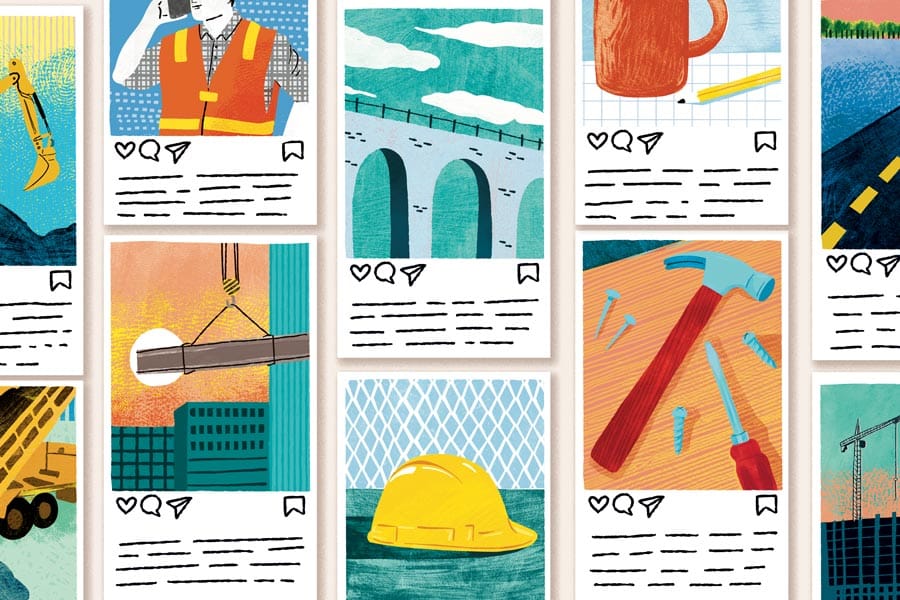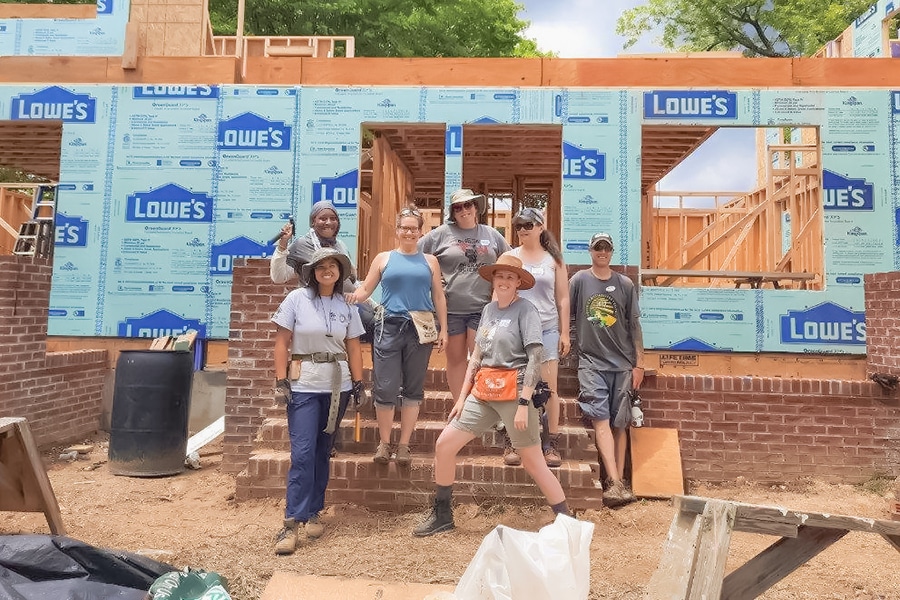Illustrated by Lindsay Gruetzmacher
There couldn’t be two worlds seemingly more different than the construction industry and the burgeoning landscape of social media “influencers.”
One is all online glamour and glitz, built on superficial personas and personalities that often feel out of touch with the real world. The other is a blue-collar profession built on hard labor and tangible results, created through in-person teamwork and difficult jobsite coordination.
But for a growing number of construction industry professionals, the two worlds have collided into a powerful force.
While most so-called social media influencers use the platforms to showcase lifestyle brands or high fashion, some construction professionals have created builder influencer personas of their own on social media, finding that documenting and promoting their craft has helped them bolster their professional networks and grow their businesses.
Building an audience
For Tim Uhler, the Awesome Framers Instagram account came from a desire to explore the world of photography. “I got on Instagram because I was into photography, and that was kind of the only game in town,” Uhler said. “I started posting occasionally about framing, but didn’t take it too seriously.”
Instagram seemed more like a place for creative exploration than a space for professional development, he added.
All that changed when Uhler attended a networking event where he met a few early construction industry influencers, who inspired him to step up his social media game. “I kind of stumbled into doing video,” Uhler said. “Just little short things, techniques, maybe it was a tool that we were using. Maybe this is what we got done that day. And gradually, it just started to grow.”
Kyle Stumpenhorst of Rural Renovators said that it was his clients who inspired him to begin showcasing his work on social media. “I realized that my clients, after I completed the job, would routinely tell me that they were happily surprised at the outcome,” Stumpenhorst said. “They didn’t always understand what they were getting. Instagram was starting to blow up, and I realized that it would be a good idea to start sharing my work with future clients that way.”
Sharing photos of the Rural Renovators team’s projects on Instagram became a way to showcase the hidden work that went into achieving the final result. “I thought that by sharing the process of what we do, it would set us apart from the people that only shared that beautiful, finished picture,” Stumpenhorst said. “I needed to showcase that we were different, that we added a different value, and educate my potential clients. And through social media, I was able to do it on my terms, at my pace, and it only cost me my time.”
The real-world impact of social media success
While their social media practices began from a desire to explore their passion for construction, both have seen the real-world impact the online world has had on their professional and business development.
“I’m at the point now where social media dictates 100% of my work,” Stumpenhorst said. “Everybody that comes to me has already checked out our social media presence and seen the type of tools we use, the work environment we maintain and the high standard we hold for ourselves. Social media has allowed me to take the stress off of the bidding process and trying to explain to a client what we’re going to bring to the table. Going into the conversation with that knowledge and trust level makes it easy for me.”
RELATED:
For Uhler, documenting his construction process on social media has helped connect to a family tradition of community-minded building. “My dad started building spec houses in the 1970s, and we continue to do that same work today,” he said. “When we’re able to post a walkthrough of a new project, or document how the building process works, there’s a relationship there when you meet clients for the first time. We’ve had customers that will follow the process for the whole house.”
Once the building process begins, Stumpenhorst said that having social media documentation in place helps clients feel more involved in their own projects. “They get to turn around and see us build and take the time and do things right for their projects,” he said. “Clients will come back and say, ‘I’m sure we would have loved your project when you were done, but I appreciate and value it at a totally different level because I was able to watch what went into it. I watched it unfold in front of my eyes.”
Online inspiration
Beyond building client connections, Uhler and Stumpenhorst said that the online construction community has provided a valuable source of professional support and growth by enabling them to connect to other industry professionals.
“I feel like the community on Instagram has been so mutually supportive,” Uhler said. “I’ll post a project, and a couple of guys will comment on ways to make it even better.”
“That’s the lovely thing about social media,” Stumpenhorst continued. “People are always willing to tell you what you’re doing wrong. A lot of people really get down on the ‘haters’ and people that are out there bashing your work. But I like to use it as an opportunity to step back and say, OK, is this a legit point of conflict? Should we talk about this? Should I find a way to do it better?’ I’ve changed many, many, many ways of building because I’ve learned from other guys that are also posting content.”
Stumpenhorst said that the online community can be a space where construction professionals come together to share discoveries and solve common industry problems. “The social media community is pushing the envelope and pushing education to the young people,” he said. “Younger people are watching and learning. I love getting messages from guys who send me pictures of their first building.”
Uhler also loves how social media brings construction professionals together from all over the world, connecting people who otherwise may have never connected and uniting construction professionals and practices that are continents apart.
“You have men, women, people from all over the world, speaking different languages, and it’s just so fun to see how different people do things,” he said. “We have a very specific way of building here in the Pacific Northwest that might not be the same as the East or the Midwest or Canada. To be able to kind of get a fresh approach because of regional differences really does make us all better. It feels more like a community than it does competitors.”












